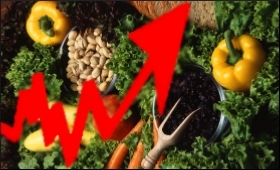|

|
Food inflation rises marinally to 16.34 percent
|
|

|
|
| Top Stories |
 |
|
|
|
SME Times News Bureau | 01 Apr, 2010
India's annual food inflation rose marginally to 16.35 percent for the week ended March 20 from 16.22 percent a week before owing to a rise in the prices of milk, fuel and lentils.
According to official data on the wholesale price index released on Thursday by the commerce and industry ministry, the index for food articles rose 0.6 percent during the week under review, while that for non-food articles fell 0.1 percent.
Taking into account the year as a whole, the prices of wheat, non-food articles, lentils, fibre and fuel were ruling sharply higher than the levels seen last year though onions and potato had become cheaper.
Following are the increases in prices of some essential food items over the 52-week period:
- Pulses: 31.55 percent
- Potatoes: (-)12.20 percent
- Vegetables: 0.62 percent
- Milk: 18.74 percent
- Wheat: 13.54 percent
- Cereals: 10.04 percent
- Onions: (-)13.38 percent
- Fruits: 10.06 percent
- Rice: 7.36 percent
Cabinet secretary K.M. Chandrashekhar Tuesday said that the food inflation was coming down, with sugar and vegetable prices falling and other indicators remaining stable.
The central bank has already initiated measures to tighten its monetary policy by hiking key rates in a bid to suck out excess liquidity from the system and tame inflationary expectations.
'Inflation pressure is stronger than we anticipated. Between November 2009 and February 2010, in a space of four months, the wholesale price inflation has gone from 5.6 percent to 9.9 percent,' Reserve Bank of India (RBI) governor D. Subbarao said Tuesday.
'We have constantly maintained about the need for exiting from the expansionary monetary policy. We have also been saying all along that we need to exit in India ahead of other countries because of the growth-inflation trade-off we are facing,' he said.
Analysts say the government's decision to raise auto fuel prices in major cities from Thursday is likely to stoke inflationary pressures further and the RBI would raise rates for the second time in as many month in its April policy review.
|
|
|
| |
|
|
|
|
|
|
|
|
|
|
|
|
|
|
| |
| Customs Exchange Rates |
| Currency |
Import |
Export |
US Dollar
|
84.35
|
82.60 |
UK Pound
|
106.35
|
102.90 |
Euro
|
92.50
|
89.35 |
| Japanese
Yen |
55.05 |
53.40 |
| As on 12 Oct, 2024 |
|
|
| Daily Poll |
 |
 |
| Do you think Indian businesses will be negatively affected by Trump's America First Policy? |
|
|
|
|
|
| Commented Stories |
 |
|
|
|
|
|
| |
|